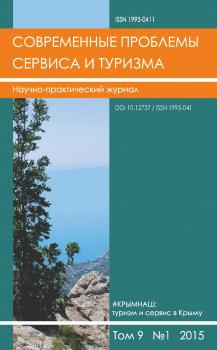Moscow, Russian Federation
The article considers the category of the «historical city», the formation features of this concept in time, the main problems and contradictions associated with the corresponding status for cities. The author substantiates the importance of participation of historical cities in various international organizations performing representative functions for them. This makes it possible to inform large number of potential tourists about the historical and cultural potential of historic cities. The article describes the international non-governmental organization League of Historical Cities (LIG), its goals, tasks, and the geography of member cities, and proposes their classification according to the spatial and-time principle. Increasing tourist fame (representativeness) in the world and the opportunities provided by LIG for information promotion is the reason for cities from different countries to desire for membership in this organization. Many historical cities of Russia, especially small and medium-sized, retain in their environment authentic stories and legends, architectural monuments, often have unique features of landscape and urban planning. Each settlement also has its own specific dates related to the outstanding events of city life. And the involvement of at least some of them in the activities of international historical and cultural organizations, for example, the League and its analogies, can be considered as world recognition. This should be regarded as one of the marketing strategy mechanisms of the city’spromotion, and its active positioning in the world market of tourist offers.
historical city, League of Historical Cities, preservation of cities’ cultural heritage, cultural heritage as a tourist resource.
1. Afanas'ev O.E. Shedevry ustnogo i nematerial'nogo kul'turnogo naslediya chelovechestva: rol' i funkcii v turizme // Sovremennye problemy servisa i turizma. 2016. T. 10. № 3. S. 7-17. DOI:https://doi.org/10.12737/21095.
2. Afanas'ev O.E. Mirovoy opyt ohrany sel'skih destinaciy kak ob'ektov Vsemirnogo kul'turnogo naslediya // Servis v Rossii i za rubezhom. 2016. T. 10. № 7(68). S. 18-33. DOI:https://doi.org/10.12737/21818.
3. Lebedev A.R. Novye tipy turizma v srednem istoricheskom gorode: sovremennoe sostoyanie i tendencii razvitiya // Sovremennaya ekonomika: problemy, tendencii, perspektivy. 2011. № 4. S. 85-90.
4. Filin S.A., Gagarina G.Yu. Turistskaya infrastruktura istoricheskih gorodov, poseleniy i turistsko-rekreacionnyh zon // Servis Plus. 2012. № 1. S. 45-49.
5. Ashworth, G., & Tunbridge, J. (). The planning, management and marketing of the tourist-historic city / The Tourist-Historic City. 2000. Rr. 135-153. DOI:https://doi.org/10.1016/b978-0-08-043675-3.50010-7.
6. Barrera-Fernandez D., Hernández-Escampa M., Balbuena A. Tourism management in the historic city. The impact of urban planning policies // International Journal of Scientific Management and Tourism. 2016. Vol.2. № 1. Pp. 379-391.
7. Brouder P., Clave S.A., Gill A., Ioannides D. Tourism destination evolution. Abingdon, Oxon: Routledge, 2017. 200 p.
8. Khirfan L. World Heritage, Urban Design and Tourism. Three Cities in the Middle East. London: Routledge, 2014. 196 p.
9. Lopez A.M. Tourism in Historical Cities. URL: https://www.academia.edu/5030140/Tourism_in_historical_ cities (Data obrascheniya: 15.05.2017).
10. New life for historic cities: The historic urban landscape approach explained. Paris: UNESCO, 2013. 24 p.
11. Orbaşli A. Tourists in historic towns: urban conservation and heritage management. London: Routledge, Taylor & Francis Group, 2015. 210 p.
12. Petrova P., Hristov D. Collaborative Management and Planning of Urban Heritage Tourism: Public Sector Perspective // International Journal of Tourism Research. 2014. Vol.18. № 1. Pp. 1-9. DOI: 10.1002/ jtr.2019.





